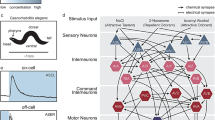Abstract
Olfactometer experiments are used to study the responses of arthropods to potential attractants, for purposes such as understanding natural defenses of plants against their herbivores. Such experiments typically lead to multivariate data consisting of small correlated counts, which are overdispersed relative to standard models. In this paper models that account for the overdispersion under different hypotheses on insect behavior are described and illustrated with an example, and a graphical approach to discriminating among them is briefly discussed.
Supplementary files giving technical computations, data and code are available online.
Similar content being viewed by others
References
Ben Akiva, M., Lerman, S., and Akiva, B. (1985), Discrete Choice Analysis: Theory and Application to Travel Demand, Cambridge: MIT Press.
Cox, D. R., and Miller, H. D. (1965), The Theory of Stochastic Processes, London: Chapman & Hall.
D’Alessandro, M., and Turlings, T. C. J. (2006), “Advances and Challenges in the Identification of Volatiles That Mediate Interactions Among Plants and Arthropods,” The Analyst, 131, 24–32.
Davison, A. C. (2003), Statistical Models, Cambridge: Cambridge University Press.
Garrow, L. A. (2010), Discrete Choice Modelling and Air Travel Demand: Theory and Applications, Farnham: Ashgate.
Kaplan, E. L., and Meier, P. (1958), “Nonparametric Estimation From Incomplete Observations,” Journal of the American Statistical Association, 53, 457–481.
McCullagh, P., and Nelder, J. A. (1989), Generalized Linear Models (2nd ed.), London: Chapman & Hall.
Mosimann, J. E. (1962), “On the Compound Multinomial Distribution, the Multivariate Beta Distribution, and Correlations Among Proportions,” Biometrika, 49, 65–82.
Rasmann, S., Köllner, T. G., Degenhardt, J., Hiltpold, I., Töpfer, S., Kuhlmann, U., Gershenzon, J., and Turlings, T. C. J. (2005), “Recruitment of Entomopathogenic Nematodes by Insect-Damaged Maize Roots,” Nature, 434, 732–737.
Ricard, I. (2008), “Statistical Methods for Insect Choice Experiments”, Ph.D. thesis, Ecole Polytechnique Fédérale de Lausanne, Switzerland.
Ricard, I., and Davison, A. C. (2007), “Statistical Inference for Olfactometer Data,” Applied Statistics, 56, 479–492.
Ripley, B. D. (1987), Stochastic Simulation, New York: Wiley.
Ryan, M., Gerard, K., and Amaya-Amaya, M. (eds.) (2008), Using Discrete Choice Experiments to Value Health and Health Care, Berlin: Springer.
Tamò, C., Ricard, I., Held, M., Davison, A. C., and Turlings, T. C. J. (2006), “A Comparison of Naive and Conditioned Responses of Three Generalist Endoparasitoids of Lepidopteran Larvae to Host-Induced Plant Odours,” Animal Biology, 56, 205–220.
Train, K. (2009), Discrete Choice Models with Simulation (2nd ed.), Cambridge: Cambridge University Press.
Turlings, T. C. J., Davison, A. C., and Tamò, C. (2004), “A Six-Arm Olfactometer Permitting Simultaneous Observation of Insect Attraction and Odour Trapping,” Physiological Entomology, 29, 45–55.
Turlings, T. C. J., Loughrin, J. H., Röse, U., McCall, P. J., Lewis, W. J., and Tumlinson, J. H. (1995), “How Caterpillar-Damaged Plants Protect Themselves by Attracting Parasitic Wasps,” Proceedings of the National Academy of Sciences, USA, 92, 4169–4174.
Vaida, F., and Blanchard, S. (2005), “Conditional Akaike Information for Mixed-Effects Models,” Biometrika, 92, 351–370.
Author information
Authors and Affiliations
Corresponding author
Electronic Supplementary Material
Below is the link to the electronic supplementary material.
Rights and permissions
About this article
Cite this article
Davison, A.C., Ricard, I. Comparison of Models for Olfactometer Data. JABES 16, 157–169 (2011). https://doi.org/10.1007/s13253-010-0042-6
Accepted:
Published:
Issue Date:
DOI: https://doi.org/10.1007/s13253-010-0042-6




